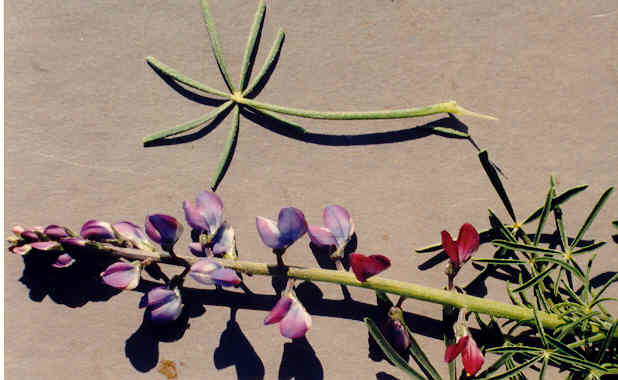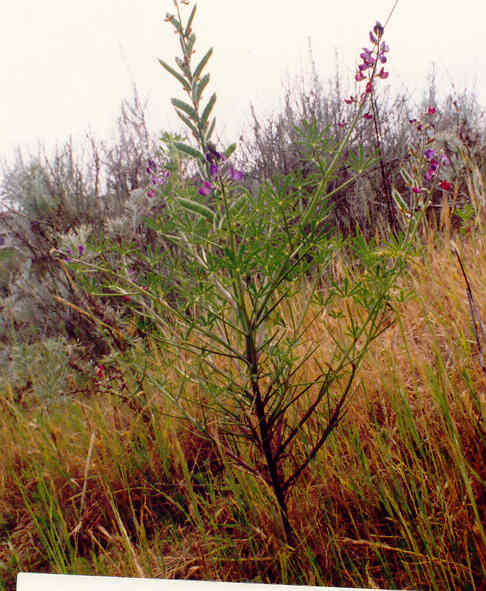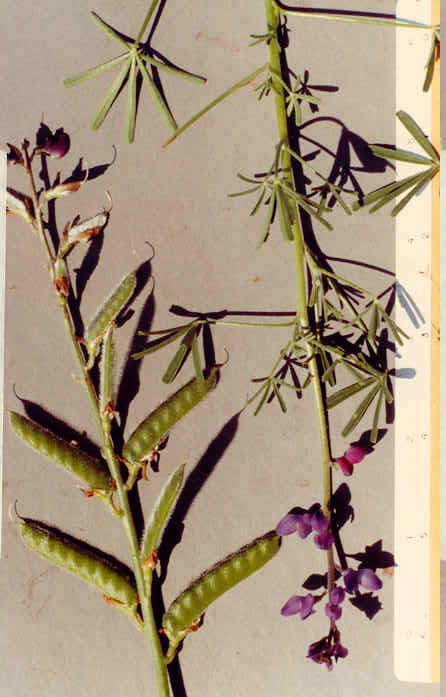
 |
Lupinus truncatus Hook. & Arn.Fabaceae (Pea Family)NativeSlender LupineCollar Lupine |
March Photo
Plant Characteristics:
Subglabrous to sparsely strigulose annual, branched, 3-7 dm. tall, rather
deep green, petioles mostly 5-10 cm. long, +/- flattened; lfts. 5-7, linear,
truncate, to emarginate or toothed, 1-4 cm. long; peduncles 3-10 cm. long;
racemes 5-15 cm. long; pedicels 2-3 mm. long; bracts subulate, 3-4 mm. long,
rather persistent; fls. not crowded, 10-12 mm. long, mostly purplish-blue,
redder in age; calyx 5-6 mm. long; the upper lip cleft, the lower entire to 3
toothed; banner ca. 10 mm. long, 9 mm. wide, keel +/- ciliate on lower edge
toward claws, more so on upper; pods ca. 3 cm. long, 6 mm. wide, villous, 6-7
ovuled; seeds ca. 3 mm. long rhomboid, plump, +/- plainly mottled with brown on
a pale flesh-color background.
Habitat:
Open grassy places, burns, etc.; Coastal Sage Scrub, Chaparral, n. L.
Calif. to Monterey Co., Channel Ids. Mar.-May.
Below 1000 meters
Name:
Latin, from lupus, a wolf,
because of an old idea that lupines rob the soil.
(Munz, Calif. Flora 804).
Latin, truncatus, cut off.
(Jaeger 272). The species
name refers to the truncate leaflets.
General:
Uncommon in the study area. Photographed
on the Castaway's Bluffs and the burn area below Eastbluff.
(my comments).
There are 62 species of lupine listed in Manual
of the Flowering Plants of California by Jepson.
Lupines are fine nitrifying plants, enriching soils in nitrates for other
plants that lack this ability. (John
Johnson). Some
but not all species of lupine hold toxic alkaloids throughout the entire plant
and are a common cause of stock poisoning.
L. caudatus is particularly toxic to cattle.
The greatest amount of poison is retained in the fully ripened seeds and
pods. Not all poisonous lupines
produce the same effects due to the varying amounts of toxic alkaloids.
Generally, within an hour after consuming the toxic parts, breathing
becomes difficult and heavy. The
body will begin to twitch; convulsions and unconsciousness may follow.
(James 45).
Text Ref:
Hickman, Ed. 636; Munz, Calif.
Flora 813; Munz, Flora So. Calif.
463; Roberts 24.
Photo Ref:
Mar 1 85 # 24A; Mar 5-April 1 85 # 5; Jan-Mar 97 # 21A.
Identity: by R. De Ruff,
confirmed by F. Roberts.
First Found: March 1985.
Computer Ref: Plant Data 78.
Have plant specimen.
Last edit 10/14/04.
 |
 |
March Photo March Photo